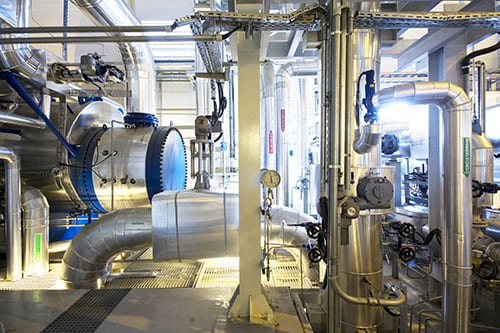Previous ChemTreat posts have outlined the importance of corrosion control in industrial steam generating systems. However, at food & beverage facilities, several specific parameters often apply to chemical treatment programs when water treatment providers are informed by their customers that the steam used for heating may touch, or may have the potential to touch, products that will be ingested by humans. Part 1 of this series focuses on steam generator condensate/feedwater issues.
Condensate and feedwater piping, and condensate return piping, is usually constructed of mild carbon steel because of a combination of mechanical/thermal strength and lower cost, as compared to other materials. Carbon steel can be very susceptible to corrosion, frequently induced by dissolved oxygen or low-pH conditions. The two together can be even more problematic. Therefore, both mechanical and chemical methods to deaerate the feedwater are typically used, along with additional chemical feed for pH control.
Compounds utilized for years in other industries to chemically control dissolved oxygen include hydrazine (a suspected carcinogen whose use has fallen into disfavor), carbohydrazide, diethylhydroxylamine, and methyl ethyl ketoxime. These compounds not only react with dissolved oxygen but can re-passivate metal surfaces that have become oxidized. However, these chemicals are often not allowed in F&B steam generators. One alternative is erythorbic acid (a vitamin C isomer), usually fed in salt form. Erythorbic acid is considered Generally Recognized as Safe by the FDA in 21 CFR 182.3041 for use as a chemical preservative in food. It reacts with dissolved oxygen and re-passivates metal surfaces.

For oxygen corrosion protection in the steam generator, and especially during outages in which the boiler must remain standing full of water, sodium sulfite is another common treatment chemical. It is non-toxic and stable for long periods. In certain applications, a catalyst may be acceptable to enhance performance.
For many industrial units, neutralizing amines are commonly used for feedwater pH conditioning. These are small-chain organic molecules with an ammonia group attached to or embedded within the structure. Common compounds include ethanolamine, cyclohexylamine, and morpholine, among others. While some of these compounds can be utilized in F&B plants, the FDA has established tight limits on steam concentrations, usually of a low part-per-million concentration. Thus, choosing the correct amine or amine blend for F&B applications is often influenced both by corrosion protection concerns and issues related to steam purity limits. Significant care must be taken in designing, monitoring, and controlling these chemical treatment programs.
ChemTreat personnel have the expertise to assist you in selecting the proper program for your plant. Contact us to schedule a consultation.
As with all other technologies, due diligence is necessary to determine the feasibility for utilizing methods. Always consult your equipment manuals and guides.

